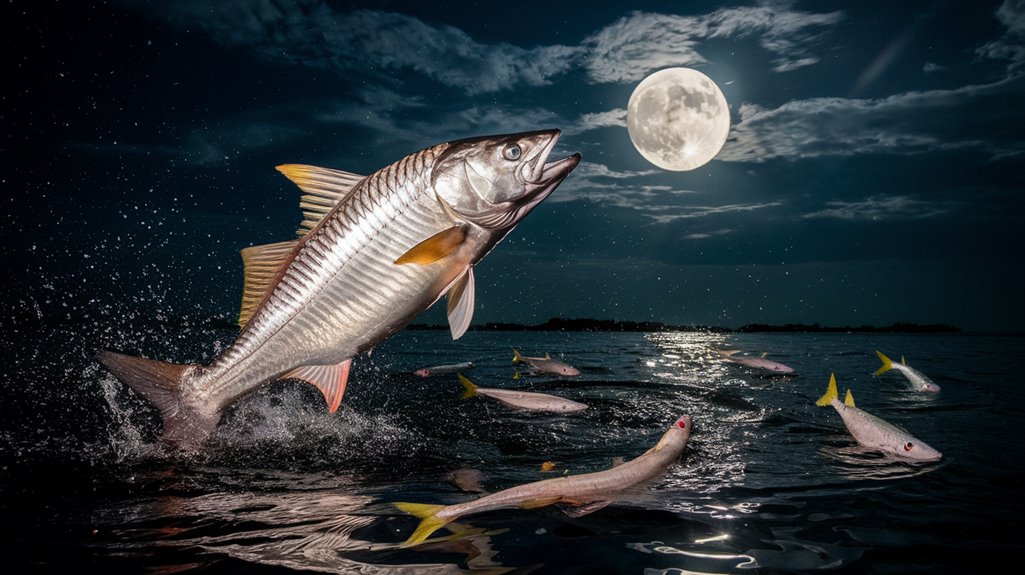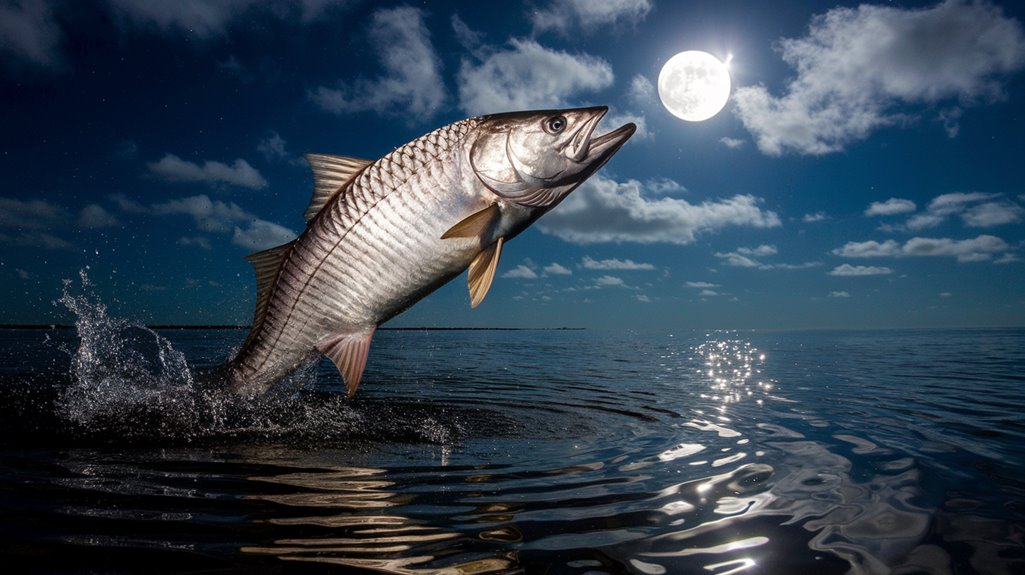You'll discover that moon phases greatly influence tarpon behavior, creating predictable patterns in their feeding habits and movements. As Earth's only natural satellite cycles through its phases, it triggers specific responses in these prehistoric gamefish, particularly during new and full moons. The gravitational forces affect tides, water movement, and bait activity – all critical factors in successful tarpon fishing. Understanding these lunar influences can transform your approach to targeting these silver kings.
- Key Takeaways
- Understanding Lunar Phases and Tarpon Behavior
- Best Moon Phases for Targeting Trophy Tarpon
- Tidal Movements and Moon Phase Relationships
- Night Fishing Strategies During Full Moons
- Seasonal Moon Phase Patterns for Tarpon Success
- Adapting Bait Selection to Lunar Cycles
- Weather Conditions and Moon Phase Combinations
- Frequently Asked Questions
- Conclusion
Key Takeaways
- New and full moons create stronger tidal movements, increasing tarpon activity and providing optimal fishing conditions during these phases.
- Tarpon exhibit heightened feeding behavior during moonrise and moonset, particularly within 45 minutes before and after these times.
- Full moons encourage nocturnal feeding patterns, making night fishing more productive with larger baits and lighter leaders.
- Cloud cover during different moon phases significantly affects tarpon behavior, potentially increasing daytime feeding during full moons.
- Peak fishing conditions occur during mid-phase moons due to strong tidal flows and more predictable feeding periods.
Understanding Lunar Phases and Tarpon Behavior
While many factors influence tarpon fishing success, lunar phases play a critical role in determining fish behavior and feeding patterns. You'll find that tarpon activity markedly increases during new and full moons, particularly during nighttime hours. However, full moons can disrupt typical daytime feeding habits, making nocturnal fishing more productive.
During mid-phase moons, you'll experience better catch rates compared to full moon periods, as strong tidal flows enhance tarpon movement and feeding activity. The relationship between moon phases and feeding periods becomes especially relevant during summer spawning seasons when full moons trigger offshore migration. To maximize your chances of success, you should align your fishing schedule with major and minor feeding periods that correspond to moonrise and moonset times, as these intervals consistently yield higher catch rates.
Best Moon Phases for Targeting Trophy Tarpon
When targeting trophy tarpon, the new and full moon phases present perfect conditions for encountering larger specimens, as these lunar periods trigger heightened feeding activity and increased movement patterns. You'll find that the Solunar Theory directly correlates with major feeding periods during these phases, particularly around dawn and dusk.
| Moon Phase | Peak Activity Time | Angling Strategy |
|---|---|---|
| Full Moon | Night Hours | Live Bait Focus |
| New Moon | Dawn/Dusk | Surface Plugs |
| Quarter | Major/Minor | Mixed Tactics |
For best results, you'll want to concentrate your efforts within three days before and after these primary lunar phases. During full moons, nocturnal fishing yields exceptional results, while new moon periods demand attention to sunrise and sunset windows when fish activity intensifies.
Tidal Movements and Moon Phase Relationships
The gravitational interplay between moon phases and tidal movements creates dynamic fishing conditions that directly impact tarpon behavior. You'll find that during full and new moons, spring tides generate stronger currents, leading to major feeding periods that can enhance your tarpon fishing success. These tidal movements greatly influence water flow patterns, creating ideal conditions during early morning and late evening hours.
- Strongest tidal movements occur during full and new moon phases
- Peak fishing conditions align with maximum water movement periods
- Major feeding periods intensify during notable lunar events
- Water current strength directly correlates with moon phase timing
To maximize your success, you'll need to carefully monitor tidal schedules in relation to moon phases, as these factors work together to influence tarpon feeding patterns and movement in your target fishing areas.
Night Fishing Strategies During Full Moons
When targeting tarpon during a full moon, you'll want to position yourself near shadow-casting structures and depth shifts where moonlight creates natural ambush zones for feeding fish. You should match your tackle selection to the heightened sensitivity of nighttime tarpon, opting for lighter leaders and scaling down lure sizes to prevent spooking these cautious predators. Your most productive fishing windows will occur during the 45-minute periods surrounding both moonrise and moonset, when tidal influences and lunar positioning trigger increased feeding activity.
Best Moonlit Casting Spots
Successfully targeting tarpon during full moon nights requires strategic positioning in ideal casting locations where moonlight and structure converge. You'll maximize your chances by focusing on areas where shadow lines meet illuminated water, creating natural ambush points for feeding tarpon. Water movement during major feeding periods intensifies around structural elements, making these locations particularly productive.
- Position yourself near dock structures where moonlight creates distinct shadow edges
- Target deep drop-offs where tidal flows concentrate baitfish activity
- Focus on mangrove edges that provide both cover and feeding opportunities
- Seek areas where strong currents intersect with structure during peak moon phases
Select spots that combine these elements while considering tide timing and lunar position to optimize your fishing success. Bright or reflective lures will enhance your presentation's visibility in these strategic locations.
Full Moon Tackle Selection
Selecting appropriate tackle for full moon tarpon fishing builds upon your strategic positioning with gear specifically engineered for nighttime success. During these peak feeding periods, you'll need to strengthen your terminal tackle with heavier leaders and reinforced hooks to withstand the amplified nocturnal strikes.
Your tackle selection should incorporate illuminated components, such as glow-in-the-dark jigs, to maximize visibility and attraction in low-light conditions. You'll find that noise-generating lures, including rattles and poppers, effectively trigger the tarpon's heightened feeding response during full moon phases. To optimize your presentation, employ tackle that facilitates extended casting distances while maintaining control for slower retrieves, allowing you to match the natural movement patterns that tarpon actively pursue under moonlit conditions.
Peak Activity Time Windows
During full moon phases, tarpon exhibit predictable feeding patterns that align with specific nocturnal windows, particularly during moonrise and moonset. You'll find peak activity during major lunar feeding periods, when gravitational forces intensify tidal movements and enhance fish behavior. To maximize your success during night fishing sessions, focus on these critical time windows.
- Plan your fishing expedition 2-3 hours before and after moonrise
- Position yourself in areas with strong tidal flows during full moon periods
- Deploy natural baits like croaker chunks when lunar activity peaks
- Adjust your fishing schedule to coincide with major lunar feeding periods
The increased illumination from the full moon improves visibility for both predator and prey, creating ideal conditions for tarpon to actively feed. Understanding these temporal patterns will greatly enhance your night fishing productivity.
Seasonal Moon Phase Patterns for Tarpon Success
Anglers who understand the interplay between seasonal moon phases and tarpon behavior gain a significant advantage in their pursuit of these prized gamefish. You'll find ideal tarpon fishing conditions during full moons in late winter and spring, when water temperatures hover around 79 degrees. However, you'll need to adjust your strategy during summer months, as full moons trigger offshore spawning migrations that reduce nearshore fishing success.
For more consistent results, target tarpon during mid-phase moons, when feeding periods become more predictable. Your success rate will improve by aligning your fishing schedule with both lunar phases and seasonal patterns. During spring migrations, you'll discover that monitoring water temperatures alongside moon phases creates a reliable framework for predicting prime tarpon fishing windows.
Adapting Bait Selection to Lunar Cycles

Successful tarpon fishing hinges on precise bait selection that aligns with lunar cycles. During full moons, you'll want to increase your bait size, using substantial chunks of croaker to match tarpon's heightened nocturnal feeding activity. For new moon phases, switch to smaller, natural baits to capitalize on major and minor feeding periods.
- Adjust lure colors and sizes during waxing crescent phases for enhanced evening success
- Match bait selection to local prey availability based on lunar influences
- Use larger baits during full moons to target nocturnal feeding patterns
- Select smaller, natural baits during new moon phases
Your bait selection strategy should evolve with the phases of the moon, considering both environmental changes and tarpon's natural prey patterns. This scientific approach to matching lunar cycles with appropriate bait choices greatly improves your chances of success.
Weather Conditions and Moon Phase Combinations
When you're analyzing tarpon behavior during different moon phases, you'll need to factor in how cloud cover can modify the moon's influence on feeding patterns. You'll observe that heavy cloud cover during a full moon can reduce nighttime illumination, potentially increasing daytime feeding activity that would typically be suppressed under clear skies. Storm systems intersecting with specific moon phases create unique opportunities, as the combination of changing barometric pressure and lunar influence often triggers heightened feeding responses in tarpon.
Cloud Cover Effects
Cloud cover serves as a critical moderating factor in the relationship between moon phases and tarpon fishing success. When you're fishing during full moons, cloud coverage can greatly alter tarpon feeding patterns by reducing ambient light levels, making fish less cautious and more likely to strike. This interaction between cloud cover and lunar phases creates distinct opportunities for strategic angling.
- Overcast conditions during full moons can increase feeding activity by providing cover for tarpon
- New moon periods combined with cloud cover offer ideal dark conditions for aggressive feeding
- Dawn and dusk periods become particularly productive when clouds diffuse remaining moonlight
- Variable cloud patterns can create intermittent feeding windows as light conditions fluctuate
Understanding these cloud-moon dynamics helps you predict peak tarpon activity and adjust your fishing strategy accordingly, maximizing your chances of success during different lunar phases.
Moon-Storm Pattern Analysis
Although moon phases markedly influence tarpon behavior, the introduction of storm systems creates complex interactions that can override typical lunar feeding patterns. You'll need to understand how these conditions interplay, as storms during full moons can greatly alter your fishing success.
When storm fronts coincide with full moon periods, you'll observe changes in water conditions that affect tarpon activity. The combination of cloud cover and atmospheric disturbances disrupts the moonlight penetration that typically guides nocturnal feeding. Storm-induced fluctuations in temperature and salinity further complicate these patterns. You'll find that wind and current variations can make bait presentation particularly challenging during these events. To maximize your success, it's crucial to analyze both lunar charts and weather forecasts, adapting your fishing strategy to these dynamic environmental conditions.
Frequently Asked Questions
What Is the Best Moon Phase for Tarpon Fishing?
You'll find ideal tarpon fishing during both new and full moons, with mid-phase periods like waxing and waning gibbous offering consistently productive conditions. Focus on 3-5 days around these lunar peaks.
What Moon Phase Is Best for Fishing?
Like nature's dinner bell, the new moon and mid-phase moons (waxing/waning gibbous) provide you with ideal fishing conditions, as they create consistent tidal flows and predictable feeding patterns.
Is It Better to Fish on a Full Moon or New Moon?
You'll find more consistent fishing success during new moons due to pronounced feeding periods and moderate tidal flows, though both phases create strong currents that can increase fish activity.
Does the Moon Affect Fish Behavior?
You'll notice tarpon actively feeding during full moons at night. The moon's gravitational pull influences tides, water movement, and fish metabolism, directly affecting their feeding patterns and activity cycles.
Conclusion
You've meticulously analyzed lunar phases and tidal patterns, yet ironically, the tarpon you're pursuing don't always follow scientific predictions. While moon-phase fishing maximizes your probability of success through increased feeding activity and tidal movements, these prehistoric fish occasionally defy statistical models. Your technical calculations of lunar periodicity won't guarantee results, but they'll greatly enhance your statistical probability of landing trophy tarpon during peak astronomical conditions.

